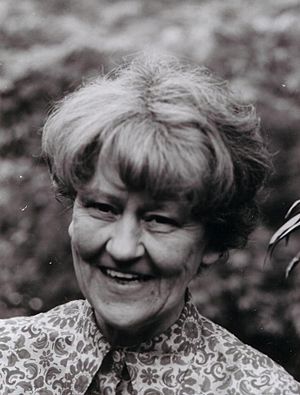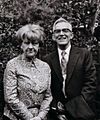Brigitte D'Ortschy facts for kids
Quick facts for kids Brigitte D'Ortschy |
|
|---|---|
 |
|
| Religion | Zen Buddhism |
| School | Sanbo Kyodan |
| Lineage | Harada-Yasutani |
| Other names | Koun-An Doru Chiko |
| Personal | |
| Born | 31 May 1921 Berlin, Germany |
| Died | 9 July 1990 (aged 69) |
| Senior posting | |
| Title | Roshi |
| Predecessor | Koun Yamada |
| Religious career | |
| Teacher | Haku'un Yasutani |
Brigitte D'Ortschy (born May 31, 1921 – died July 9, 1990) was also known by her Zen name, Koun-An Doru Chiko. She was a talented architect, journalist, and translator. She made history as the first Zen master from Germany in the Sanbo Kyodan school of Japan.
Contents
Brigitte D'Ortschy's Early Life and Career
Brigitte D'Ortschy grew up in Berlin, Germany. As a teenager, she loved reading books by thinkers like Angelus Silesius and Meister Eckhart. These books made her curious about deep spiritual ideas.
She studied architecture and engineering in Berlin and Graz. She was very interested in how buildings affect people and society. In 1945, she earned her diploma in architecture.
After her studies, Brigitte worked at the Technical University of Munich. She researched the history of buildings. In 1950, she visited the United States to learn about city planning. This was to help rebuild Germany after the war. She also worked for the Planning Commission of Philadelphia. During this time, she met the famous architect Frank Lloyd Wright.
Working with Frank Lloyd Wright
In 1951, Brigitte helped start a committee for urban planning in Bavaria. In 1952, she brought an exhibition about Frank Lloyd Wright's work to Munich. Wright was so impressed that he invited her to work at his studio in Arizona in 1953.
Frank Lloyd Wright believed in "organic architecture." This meant designing buildings that fit naturally with their surroundings. Brigitte really liked this idea. It helped her understand how buildings and designs can be like a "cultural language." This understanding later helped her appreciate Japanese culture.
After returning to Europe in 1954, she organized many art and design exhibitions. She also wrote articles and gave lectures. In 1960, she organized the first exhibition about Israeli art in Germany.
During these busy years, Brigitte read a book called Zen and the Art of Archery. This book sparked a strong feeling in her. She later wrote that it made her feel Japan held "something extremely important" for her. By 1963, she decided to move to Japan.
Zen Training and Teaching in Japan
Soon after arriving in Japan, Brigitte D'Ortschy met Zen Master Ryoko Roshi. In April 1964, she began her serious Zen training under him. She trained in temples in Tokyo and Kamakura.
To support herself, she taught at universities in Japan. She also wrote many articles about traditional Japanese culture and its Zen art forms.
Becoming a Zen Master
Brigitte went through intense Zen training, including studying many koans. Koans are like riddles or stories used in Zen to help students gain insight. She finished this training in 1972. Her teacher, Yasutani Haku'un Roshi, gave her the Dharma name Doru Chiko Daishi. This meant she was now his Dharma heir, a recognized successor.
In 1973, another Zen master, Koun Yamada Roshi, also recognized her. He gave her the name Koun An Roshi. From then on, she was known as Koun An Doru Chiko Roshi. In 1983, Yamada Roshi confirmed her as a true Zen Master (Shoshike) in the Sanbo Kyodan lineage. This made her the 85th generation after Gautama Buddha and the 35th generation after Dōgen Zenji.
Important Friendships and Translations
While training, Brigitte became friends with Philip Kapleau. He was writing his famous Zen book, The Three Pillars of Zen. Brigitte designed the cover for his book. She also translated it into German. She even re-translated some parts from old Chinese into English first, to make sure her German version was very accurate. The German book was published in 1969.
She also became friends with Catholic priests who were studying Zen. One close friend was Father Thomas Hand. They exchanged letters for 20 years, showing how Zen and Christianity could connect.
Teaching Zen in Germany
From 1973, Brigitte D'Ortschy began leading Zen retreats (called Sesshin) in Germany with Yamada Koun Roshi. In 1975, she opened her own Zen center (zendo) in Munich. This center grew into a community with students from all over the world.
Koun An Roshi taught during intense summer training periods. In winter, she continued her own Zen training in Japan. She also worked on her translations and writings. She kept her Munich zendo private. This was to ensure her students had a focused and real Zen training. She believed that "spiritual training is always for free."
Under the name Michael Mueller, Brigitte published a Zen talk (teisho) about the koan "MU." It was published in 1984 with the title ZEN.
Until her death in 1990, she spent winters in her small hut in Japan. She continued her own Zen practice and translated classic Zen texts. She translated important works from Chinese and Japanese into English and German. These included texts like The Gateless Gate and The Blue Cliff Record. She also wrote her own talks about these koans.
Brigitte D'Ortschy's work helped connect Zen Buddhism with Western culture. She is seen as the first German Zen Master. She had students from many different countries.
Gallery





